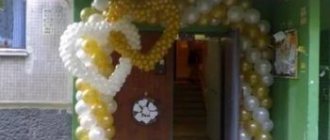It is difficult to imagine a traditional wedding without competitions. The ransom, entertaining the guests and the young couple at the banquet always takes place with them. One of the traditional options is the “Chamomile” competition at a wedding. It gives room for imagination and is quite easy to implement. “Chamomile” appeared in ancient times. The girls guessed “loves or doesn’t love” by the petals of a snow-white flower, symbolizing love. The questions for the wedding game “Chamomile” are slightly different from the old version; their task is to find out how well the couple knows each other, and, of course, to amuse all the guests.
What is chamomile for young ransom?
The wedding daisy for the bride price is a test during which the groom demonstrates how well he knows his future wife. Guests conducting the ransom prepare tricky questions that relate to the young woman, her family, tastes, preferences, dreams and goals. All information is written down on separate paper flower petals . Petals can be made not only from paper, but also from other materials.
Photos of wedding daisies for bride price
In advance, the young woman’s friends will learn from her the answers to the prepared questions. To ensure that nothing slips out of your head during the competition, you can write them down next to the questions. The main thing is to make sure that neither the groom nor his companions see anything.
But even if this happens, the answers of the future spouse will still be counted, since it does not matter at all how exactly he will obtain them
After each positive answer, one of the flower petals is torn off. If the young man does not know the correct answer, then he is allowed to buy the petal for money or candy. As soon as there is not a single petal left on the flower, the competition is considered completed.
Options
The purpose of the competition is to amuse the guests and the young couple, so you should not come up with tricky questions or dry texts. It is better if the answers are humorous and harmless . The competition should be run by an active bridesmaid or wedding host. If questions are written on the petals, the person conducting the competition should think about the answers in advance, write them down with a pencil on the other side, or make a reminder in any other way, so that during a moment of fun he does not accidentally forget the intended text.
After the answer to the question is received, the petal is torn off from the chamomile. At the redemption, an incorrectly given answer can be replaced with money, thus redeeming the petal. When all the petals are torn off, the competition ends . The duration of “Chamomile” should not exceed a quarter of an hour, otherwise guests and young people may get bored.
It is important to provide simple questions and short answers so that the entertainment does not drag on
At the banquet, you can do without questions, and make the “Chamomile” competition a kind of ritual by writing the necessary words of love or distribution of responsibilities on each petal, which the young people will take turns tearing off and reading.
Colored chamomile for ransom
Making chamomile for ransom with your own hands
Making a daisy for a wedding competition is very easy. All you need as test elements is “daisy”. Of course, if you don’t want to, you don’t have to make the props yourself, but buy them at a wedding accessories store.
Photo of a wedding chamomile for the bride's ransom with your own hands
If you decide to make a flower yourself, you will need to prepare whatman paper, a stencil, paints, colored paper, pencils, markers and a stapler. How to proceed :
- A template of chamomile petals is made on whatman paper for the bride price.
- On paper you need to draw a circle and as many ovals as there are planned questions. To save material, you can cut them out in a separate order. But in this case, they will need to be attached to the core using a stapler or tape after decoration.
- To decorate a flower, you can take any paints, felt-tip pens, or colored pencils. Even multi-colored paper works.
- So, we draw the outlines of future petals on whatman paper with a simple pencil and cut them out. Particularly caring girlfriends can make a real masterpiece from an ordinary chamomile, which the young woman will later keep as a keepsake.
Questions are written in large letters of a contrasting shade, so that if something happens the groom can read them himself
Scenario
There are many legends why chamomile is considered the best predictor of feelings during a wedding.
Some said that this was a gift from God, which symbolized the heavenly body, so that people looking at their feet would more often remember the warm sun.
Others believed that this was the trace of a fallen star, which marked the birth of a fortuneteller, so chamomile is used in the most important matter - when trying to find out about the feelings of the object of desire.
Playing daisy at a wedding is quite interesting and multi-variant. The most common are purchased daisies, on which tasks for the groom are written - after all, at first such entertainment was chosen as a ransom for the bride.
But after that the competition switched to regular wedding competitions.
Ways to create tasks:
- The challenges are created by the newlyweds, and the participants need to do some kind of action.
- The organizers write a question on the back, and the competitors must answer quickly. A more complex option is written numbers or dates. Then the participants tell what happened to the newlyweds on that day or what these or other numbers refer to.
- Guests come up with questions or tasks, and participants must guess or show what is written on the cards.
Most often, a competition is held to guess questions about young spouses asked by the organizer. But many guests have already encountered this option, and it makes sense to create a more fun option, despite the complexity of its implementation.
Suggested Questions
A daisy competition at a wedding can consist of a wide variety of questions. They can be like this:
- Name the date you met your future wife.
- What date was your first date?
- When did you first kiss?
- How many children does the young woman want to have?
- What was the name of her first teacher?
- Under what zodiac sign was your mother-in-law born?
- What size is the bride's engagement ring?
- How much does your beloved weigh in grams?
- What color do you like best?
- Say the words that you said at the moment of your marriage proposal.
- What is the age of the future spouse in days?
- What color are your father-in-law's eyes?
- Where does the future spouse want to live?
- What is the young man's hobby?
- What is the betrothed's waist size in millimeters?
- What kind of cars does the bride like?
- On which shoulder does the chosen one have a mole?
- What animal does your lover compare you to?
- What does she like better: cake or ice cream?
- Which writer's work does she like?
This is not a complete list of questions. They should not be too difficult or too easy. It’s better to write questions that test your composure and intelligence. It’s like asking a question about a mole: if a young woman doesn’t have one at all, then I wonder whether the future spouse will immediately give the answer or will it take a long time and painfully to remember?
Photo of a chamomile with questions from the bride to the groom
When preparing the test, it is better to discuss everything with the bride herself: she will tell you which questions the future spouse can answer immediately, and which ones will make him confused. The main thing is that everyone present has fun, interesting and funny.
Future event scenario
To make the “Chamomile” competition with questions as interesting as possible, girlfriends are advised to come up with an accompanying text for it. You can write it either in the form of a poem or in the form of prose. It all depends on the talent and imagination of the authors. It is not advisable to make the text too long by using a huge number of words. After all, the ransom should not be boring and should go through as quickly as possible.
Photos of daisies for a competition with questions at a wedding
Here is one version of the proposed text: “Now, dear young man, we will try to find out how sincere your feelings are to marry our friend. Let's remember what our Anechka (the name of the bride) told you herself, and what you learned about her on your own. We have prepared a chamomile for you , but not a simple one, but with tricky questions. Each correct answer will give you a petal. You will have to pay for mistakes. Until the chamomile is left without petals, you won’t get to your future wife.”
It is advisable to memorize the text so that during the action you do not look funny and do not “mumble”, remembering the necessary words on the go
When the bride price takes place, the groom is very worried and may be confused when answering even the simplest question. There is no need to reproach the young man for this, because if he did not feel love for his lady , she would not have given her consent to marriage.
The goal of the competition is to please the guests, and not to drive the future husband into a corner. To ensure that the ransom is not trivial, it is better to show all your creativity and imagination when preparing it. Today, not many couples agree to host such an event, so if the bride and groom decide on a daisy, then they need to make it stunning.
Didactic manual “Chamomile of Desires”
Kuznetsova Tamara
Didactic manual “Chamomile of Desires”
Description: The manual is intended to identify inclinations in the preferred activities of children, uniting children with different skills in certain activities of interest, planning individual work with the child in order to increase interest in the least preferred activity, taking into account seasonal requests, children’s interests, preparing and changing the subject - developing environment in accordance with the desires and interests of the child .
The Sun of Wishes is a set of pictures depicting objects that children can use in a preschool institution, in our case, these are the centers of the subject-development environment:
Literacy and Drama Center - where children can look at illustrations, work in a book corner, and play drama games;
center for nature and experimentation - children can carry out activities in a corner of nature, be on duty, conduct experiments, play didactic games of an environmental nature, games with natural materials and much more;
art center - where children’s visual and musical activities are carried out, independent or joint work with various art materials (plasticine, paints, pencils, clay, wax crayons), musical and didactic and art-didactic games , musical instruments are widely presented in the corner...
architecture center - constructive activities for children: in the center there are different types of construction sets, cubes, toys for playing with buildings, building diagrams, models, various materials, manuals to complement the architectural design;
Mathematics Center - here are logic and educational games, board and printed games, puzzles, a non-standard aid for counting...
health center – where children can play outdoor games and carry out activities with sports equipment.
An image of a tree - a walk, a doll - toys for girls, an airplane - toys for boys, a backpack - the child has a desire to study .
A question mark means that the child, according to his own idea, comes up with a type of activity. Each kit also includes a photograph of each child.
Target
Identifying the inclinations and preferred activities of children, uniting children with different skills in certain activities of interest, planning individual work with the child in order to increase interest in the least preferred activity.
Methodology:
The chamomile of wishes is hung in the group so that children can freely come up and look at the pictures. The teacher asks to name the objects located on it. After all the cards are named, the teacher talks about how each picture depicts a certain type of activity, for example a book - reading by the teacher or the child himself, looking at illustrations, etc.
Next, the teacher clarifies the knowledge of symbols through the game, for example: I want to go for a walk, the children show a card with a picture of a tree.
Then the teacher asks the children to name what they want to do and show it in the picture.
At the end of the game, the teacher draws the children’s attention to the rays - stripes and tells them what they are for (photos of the children will be attached to them)
.
The teacher suggests once again remembering the designation of each picture, finding his photo and marking what he would like to do today, placing his photo under the desired picture. Next, work with children continues. During the day, the child can put his photo in accordance with his wishes .











